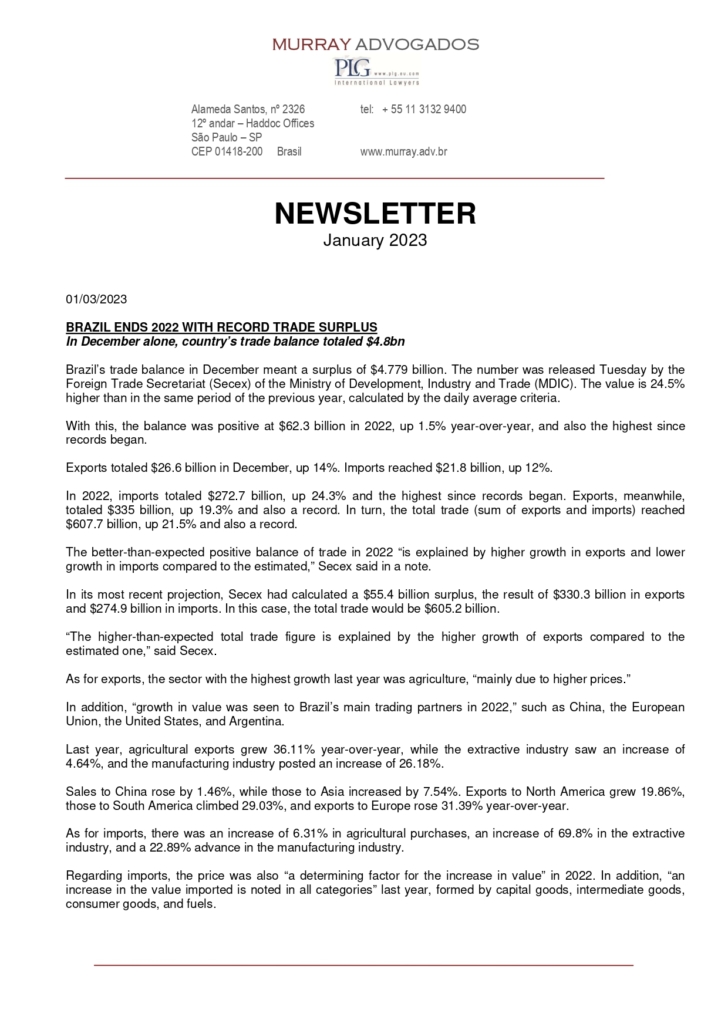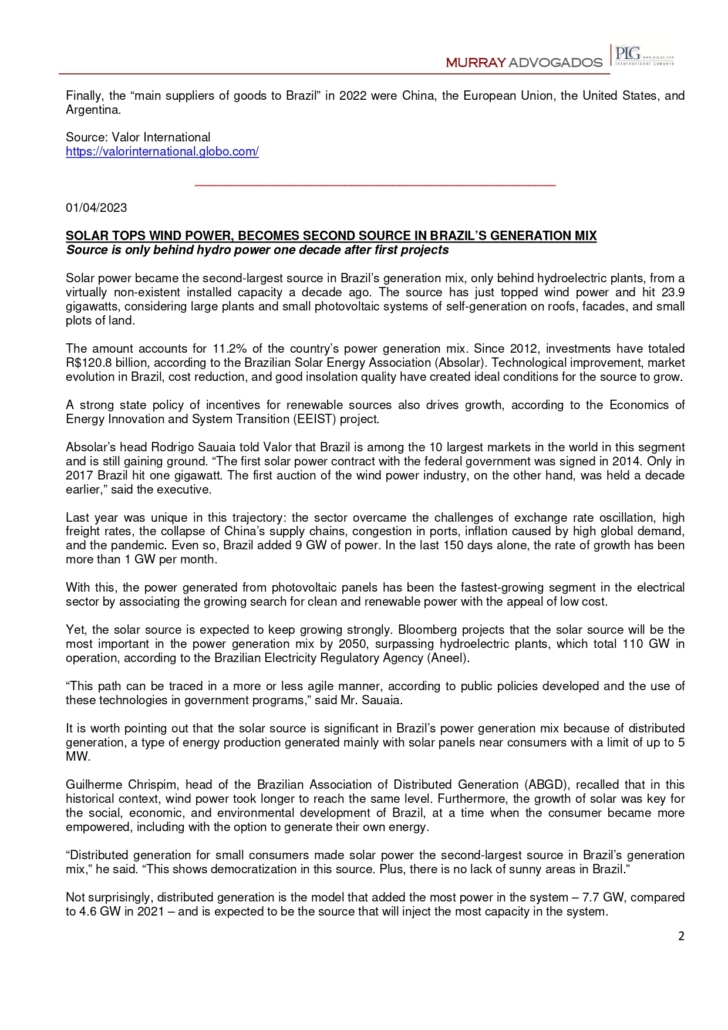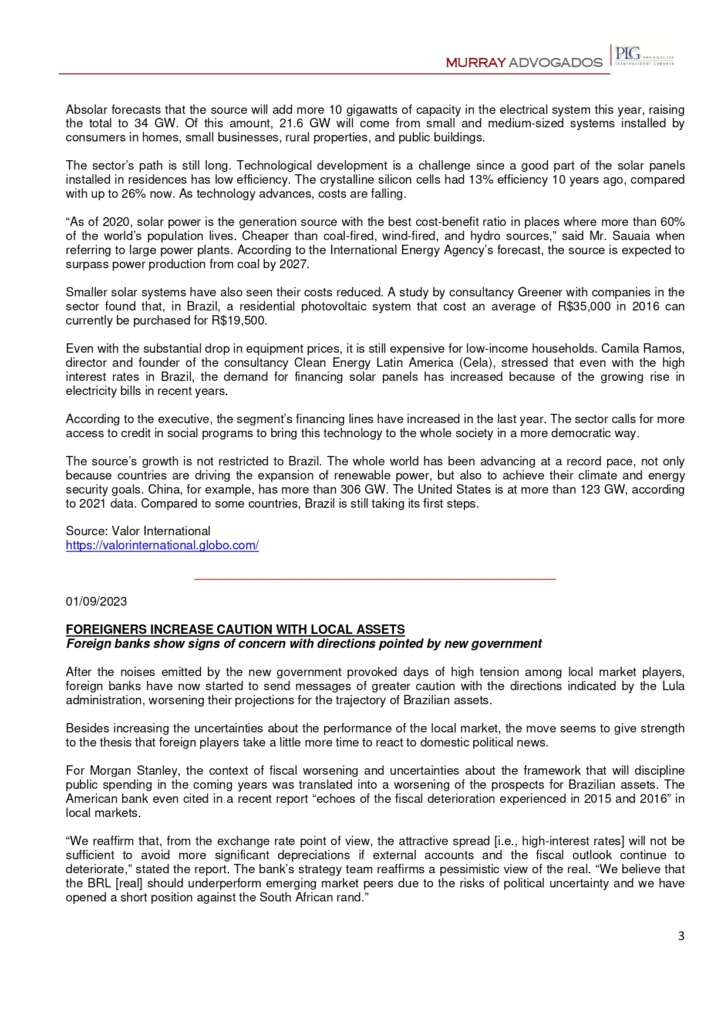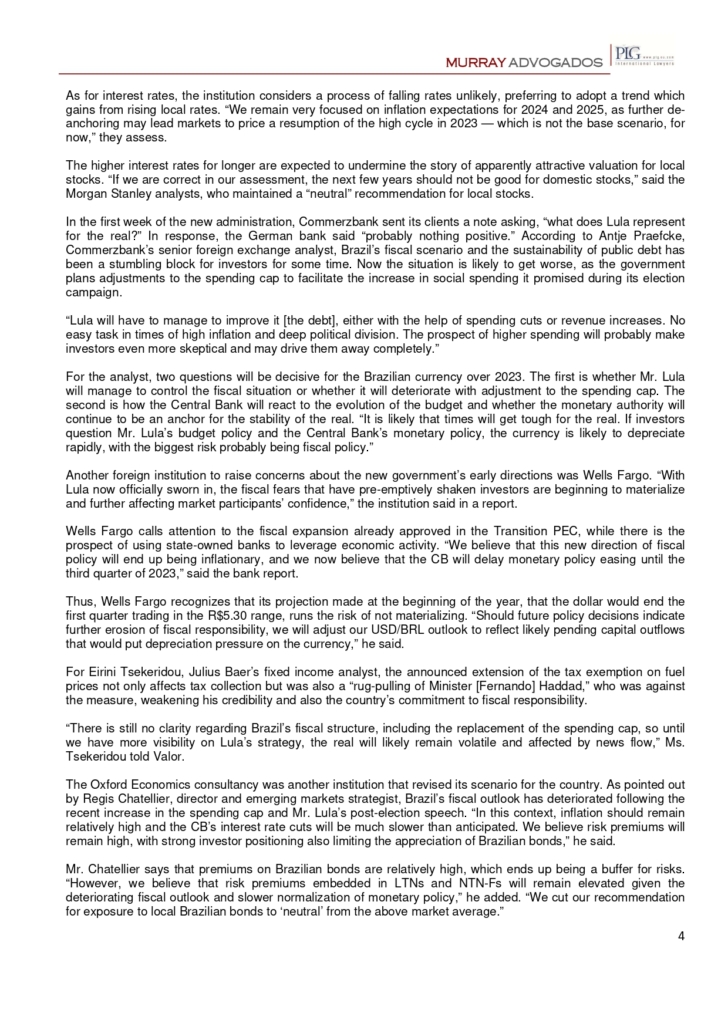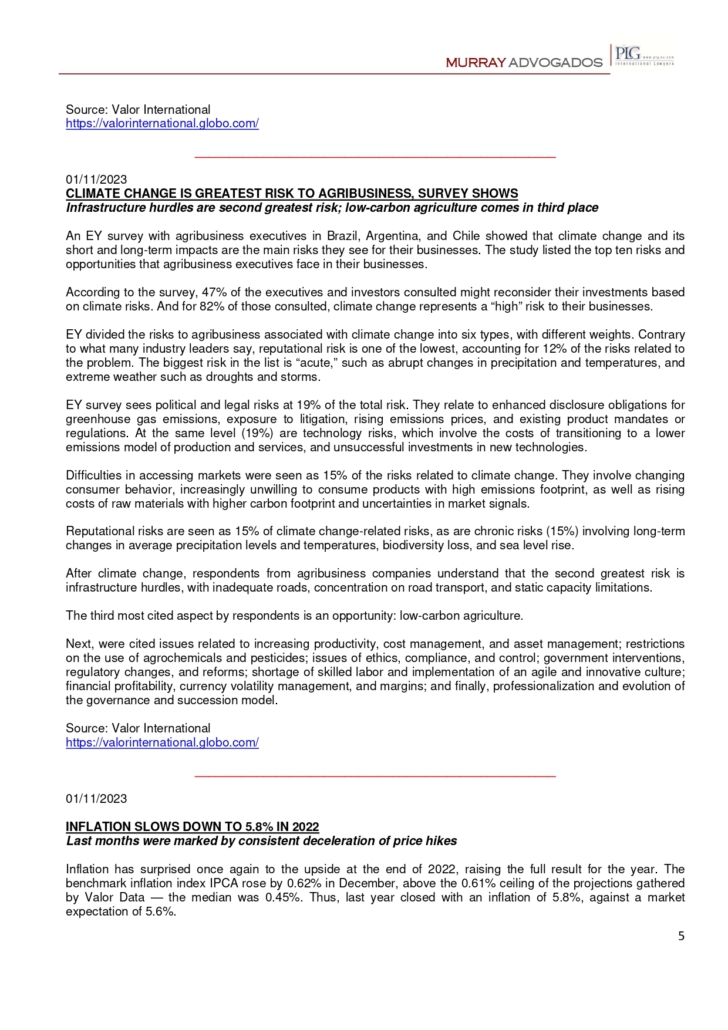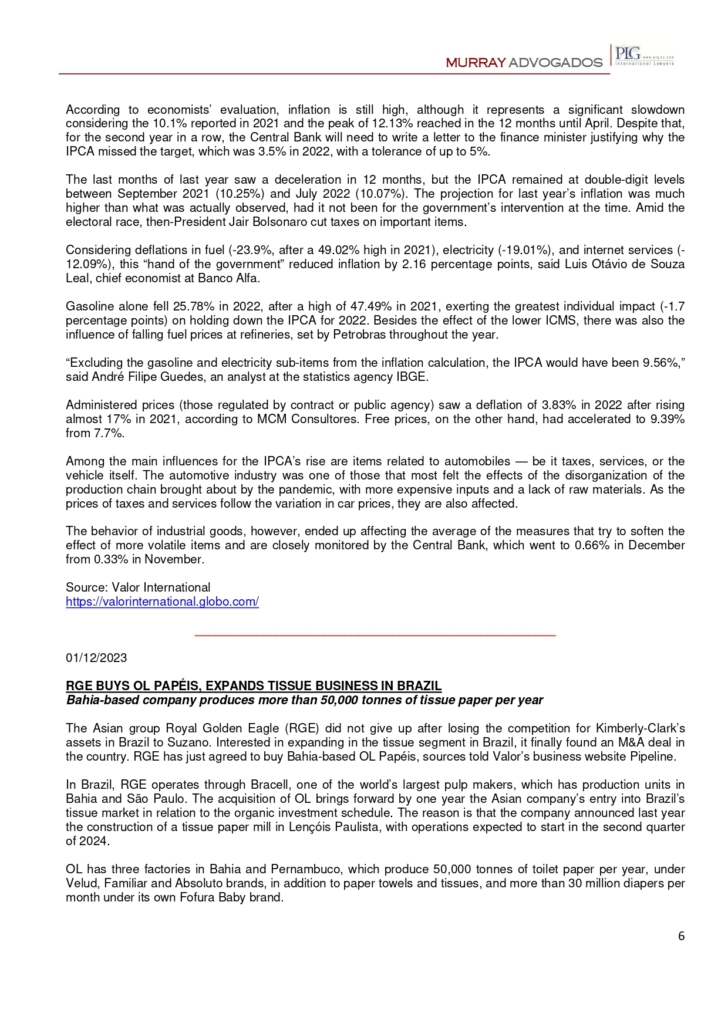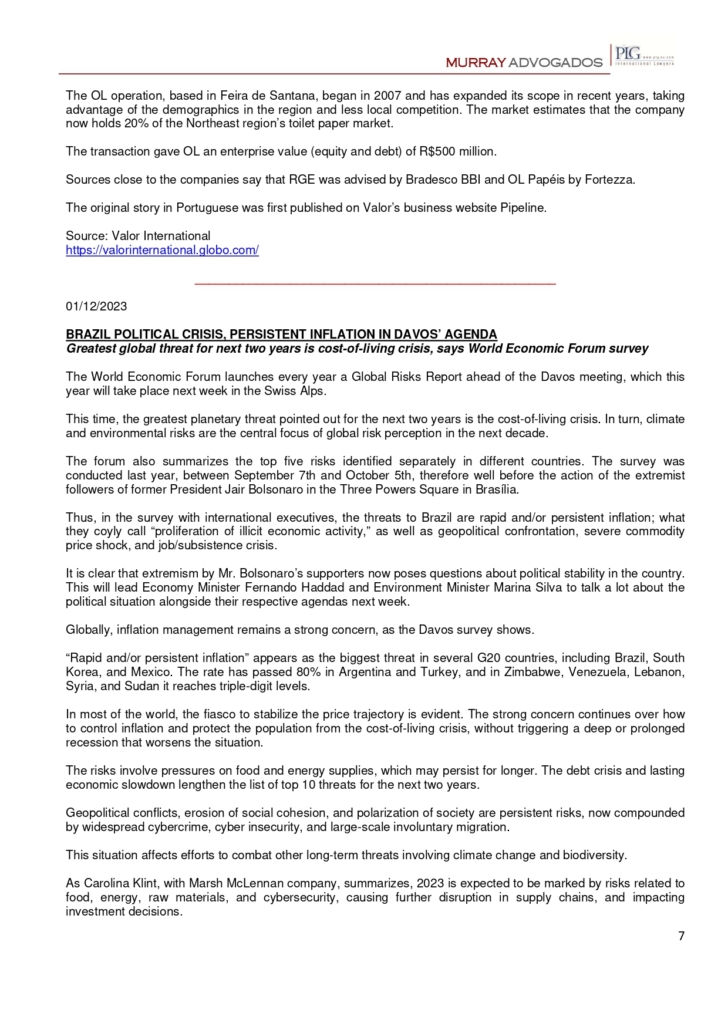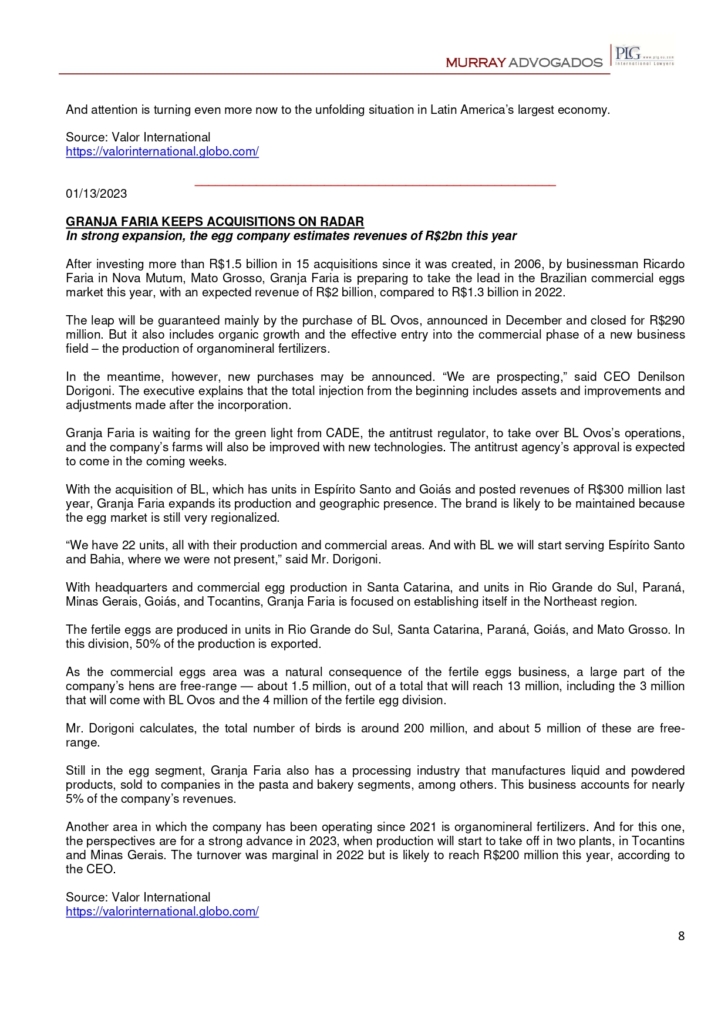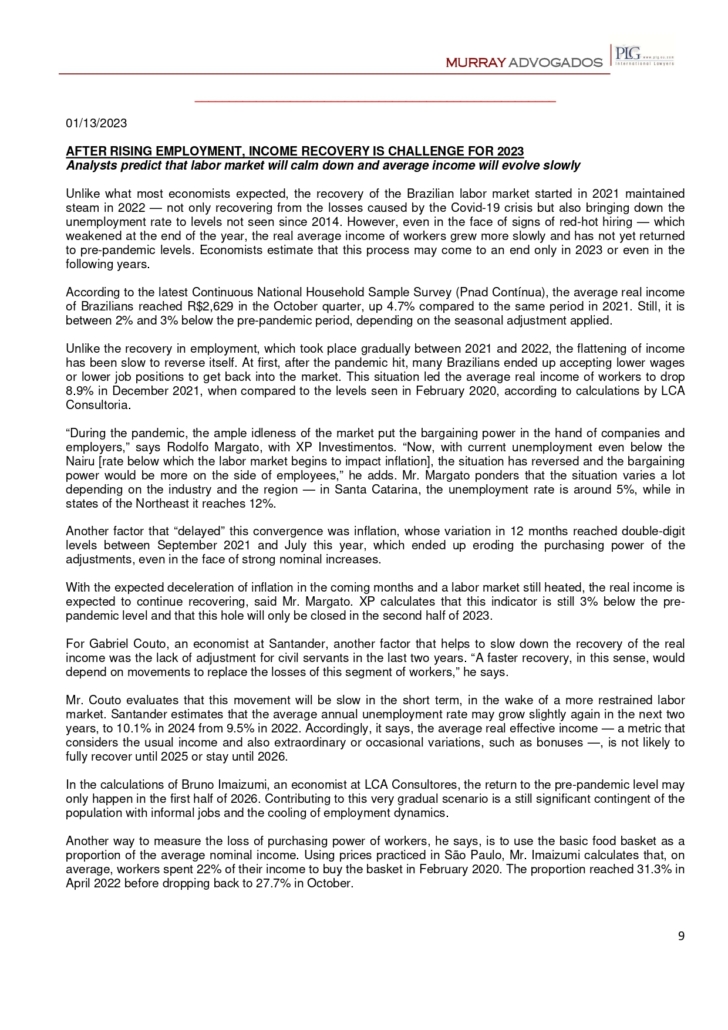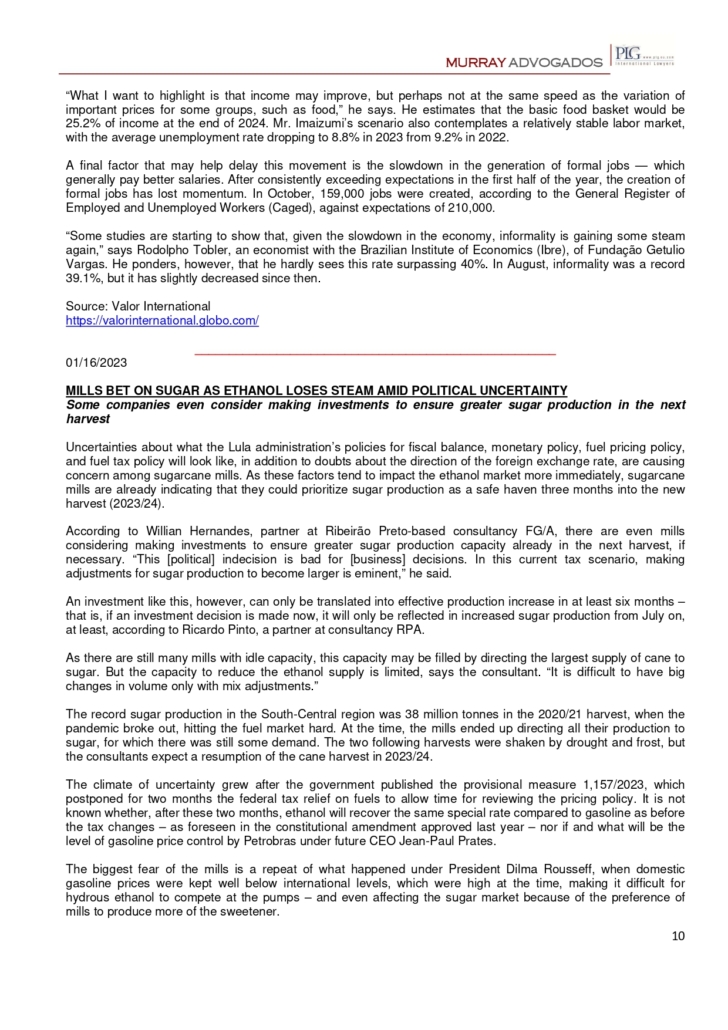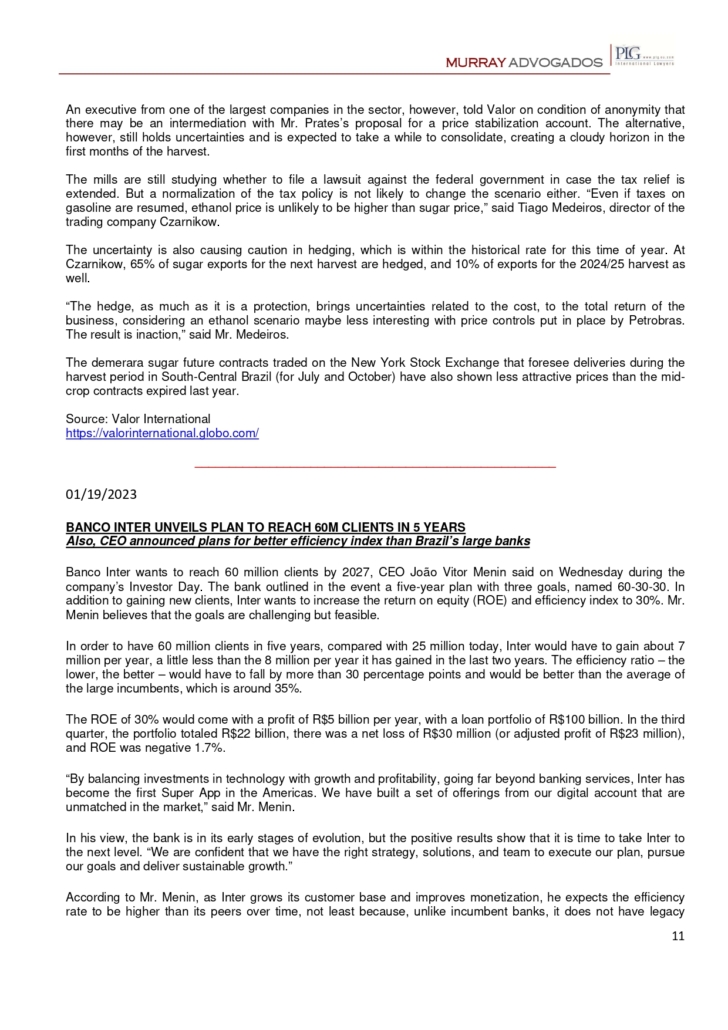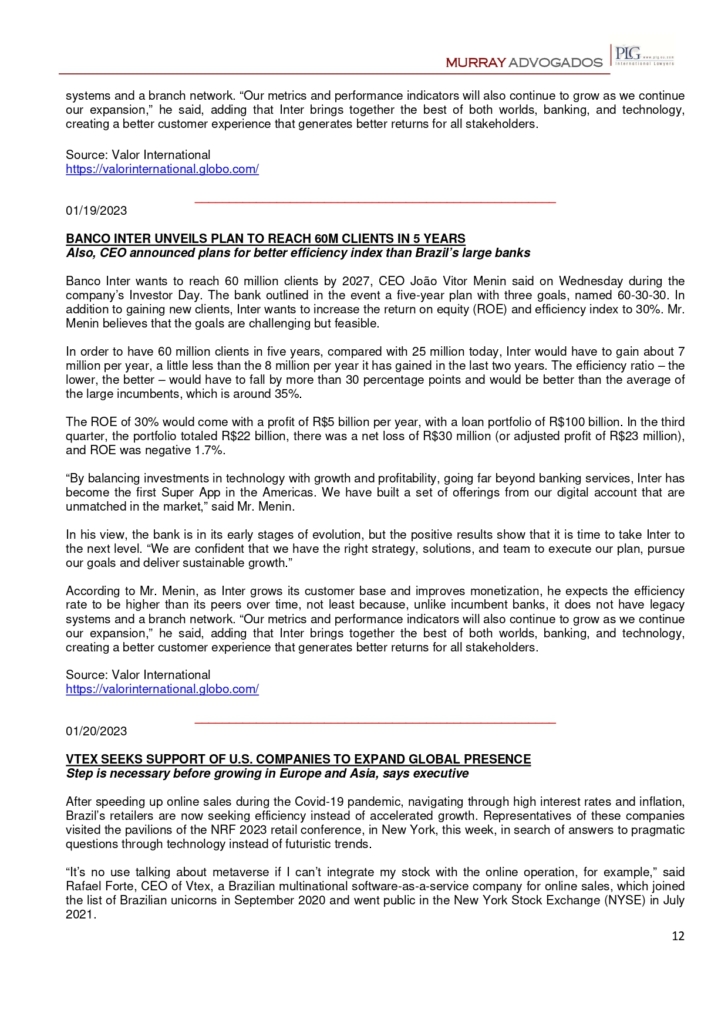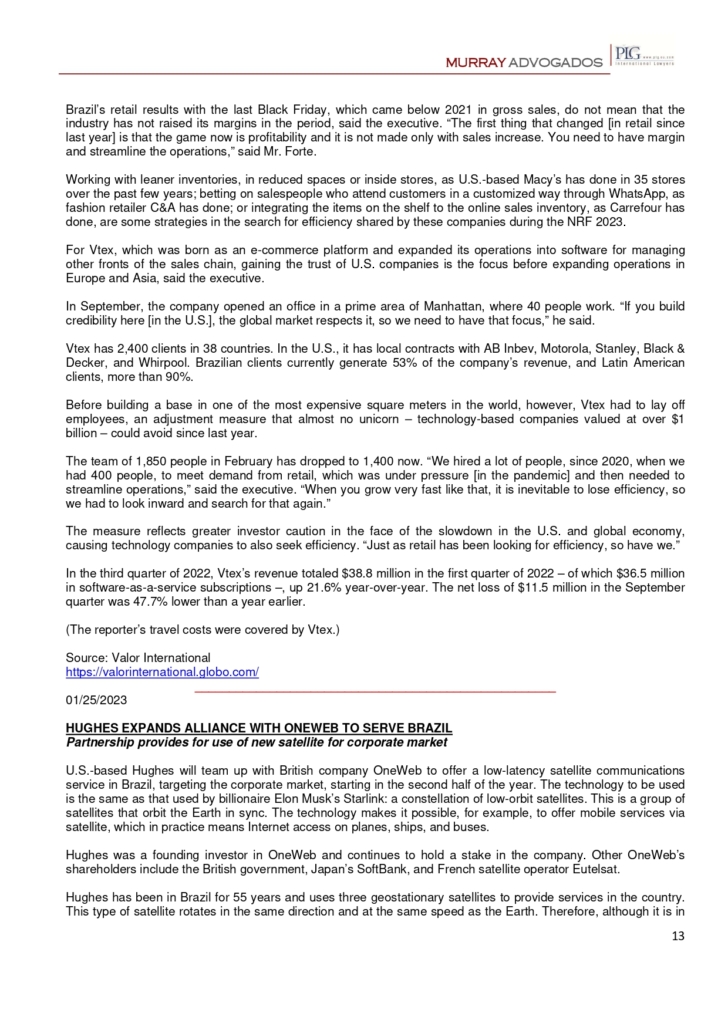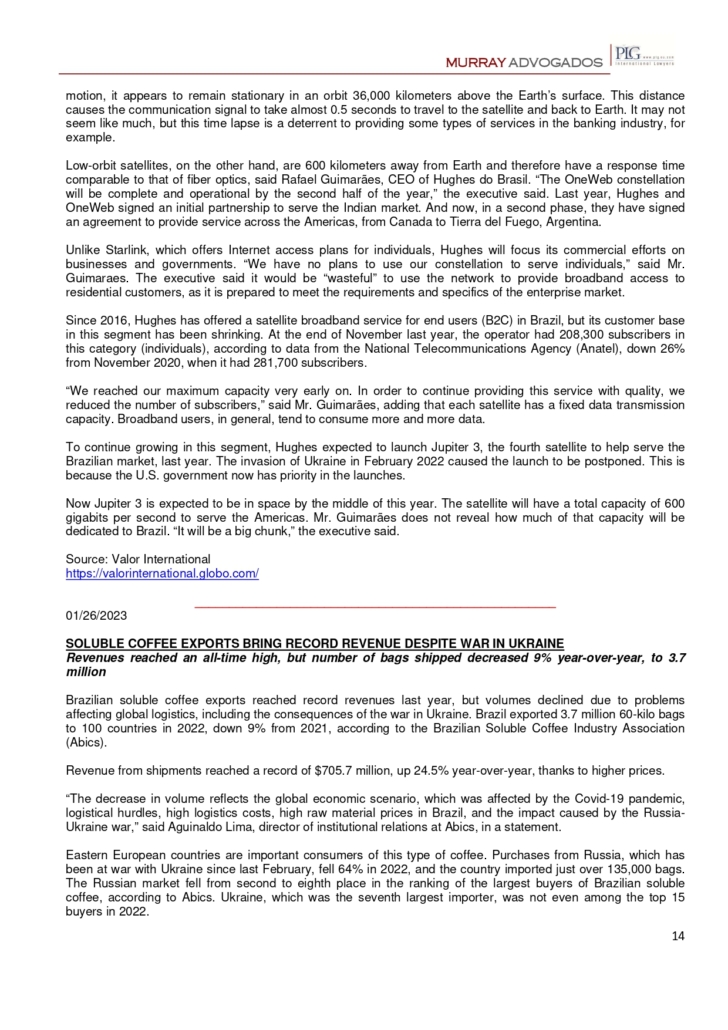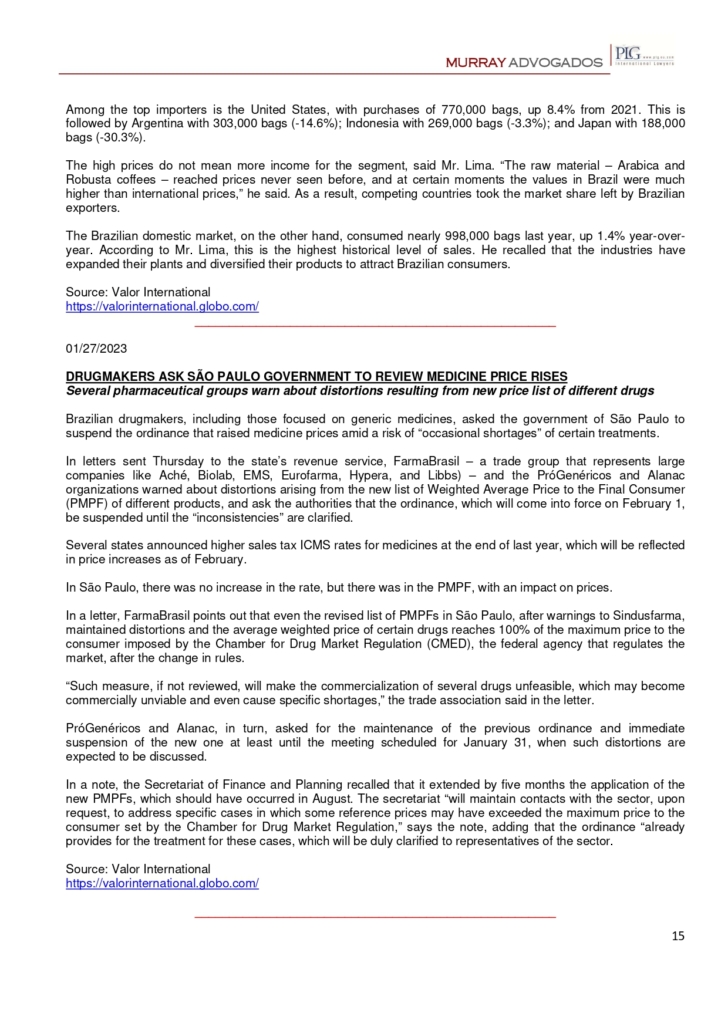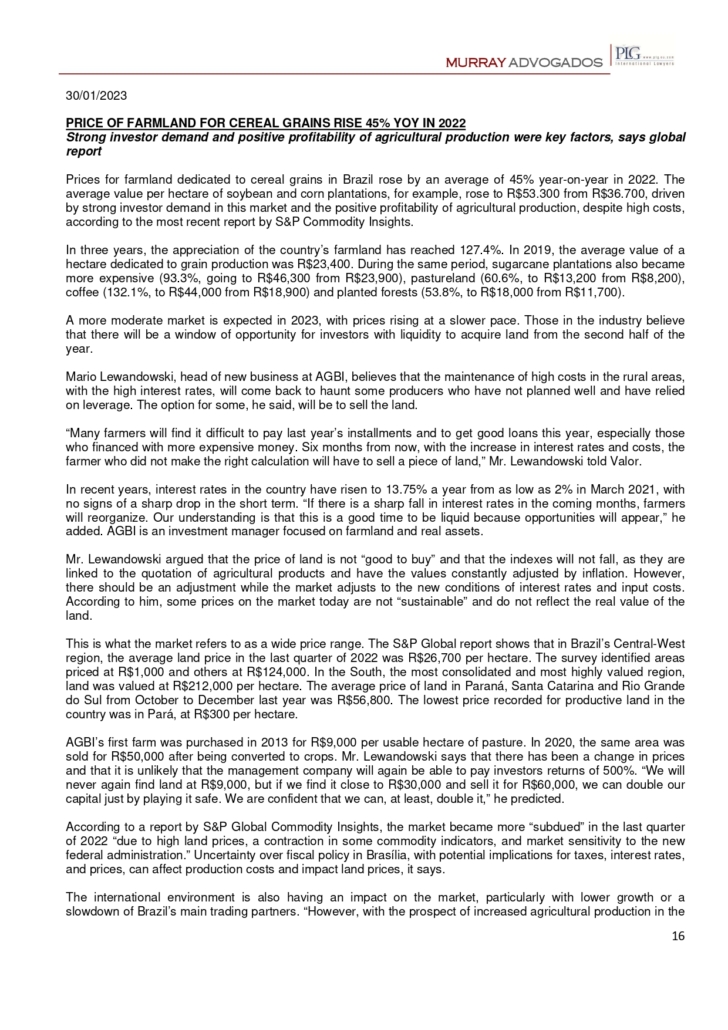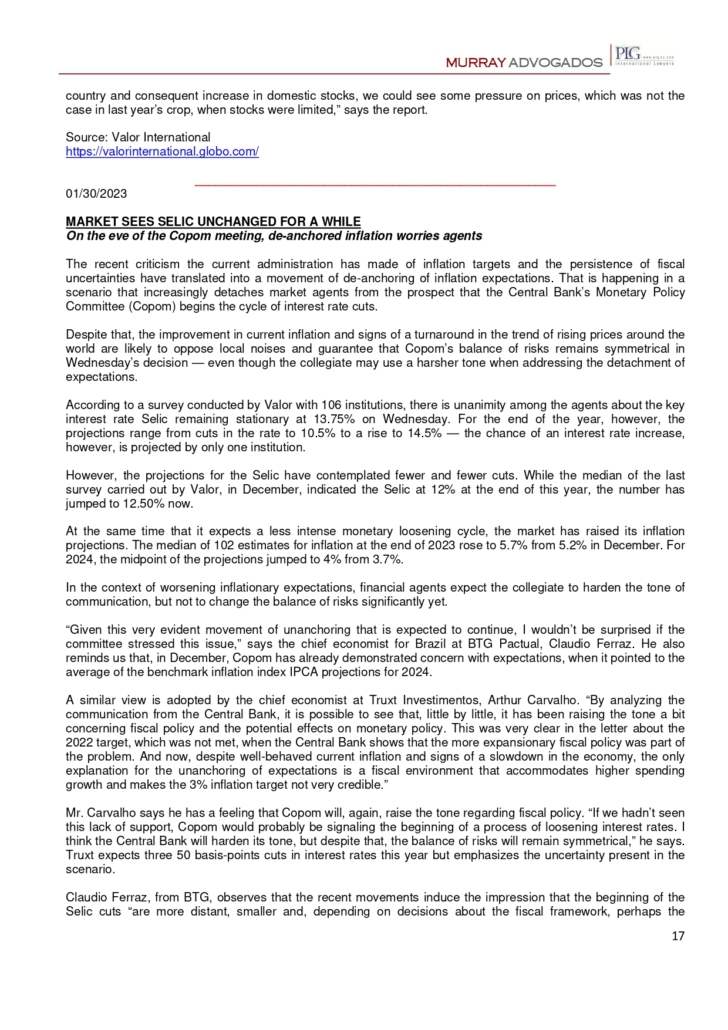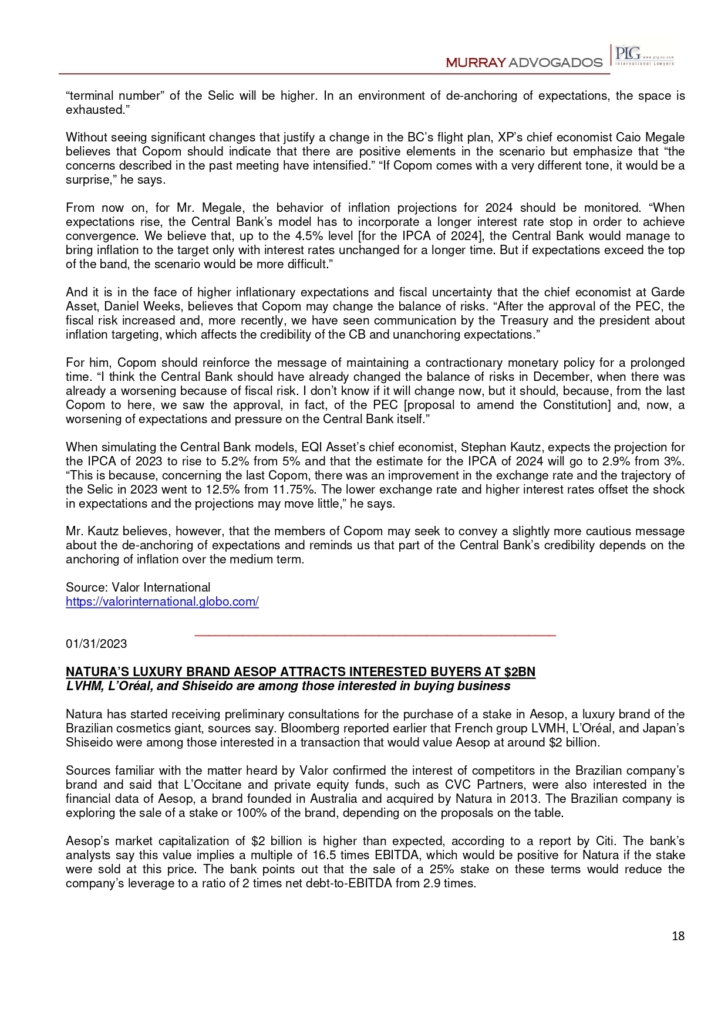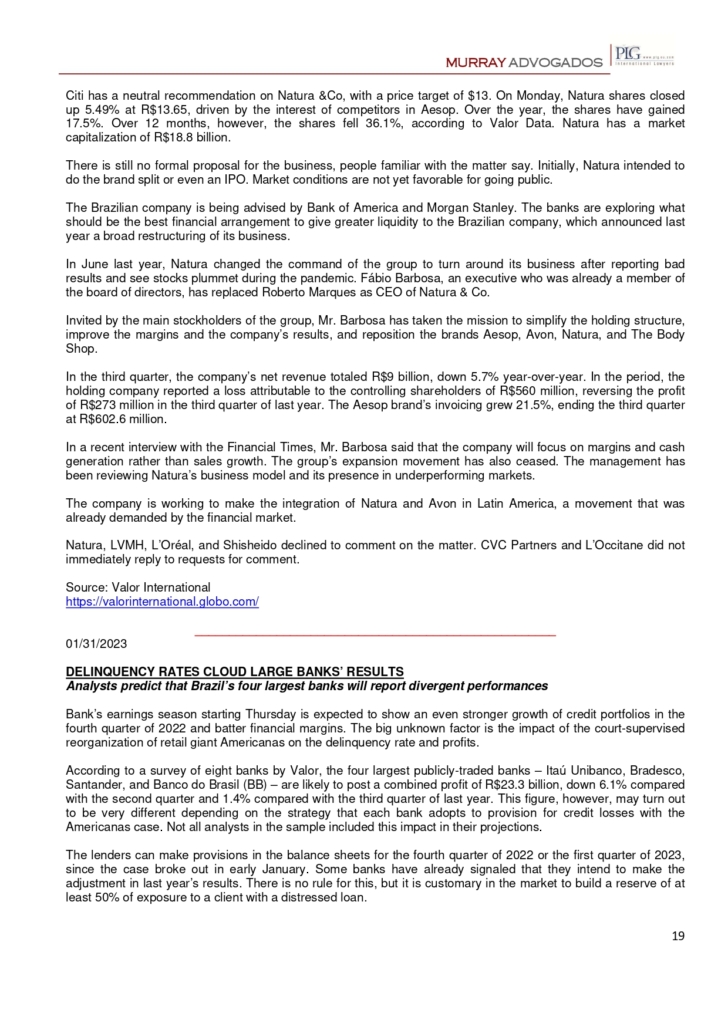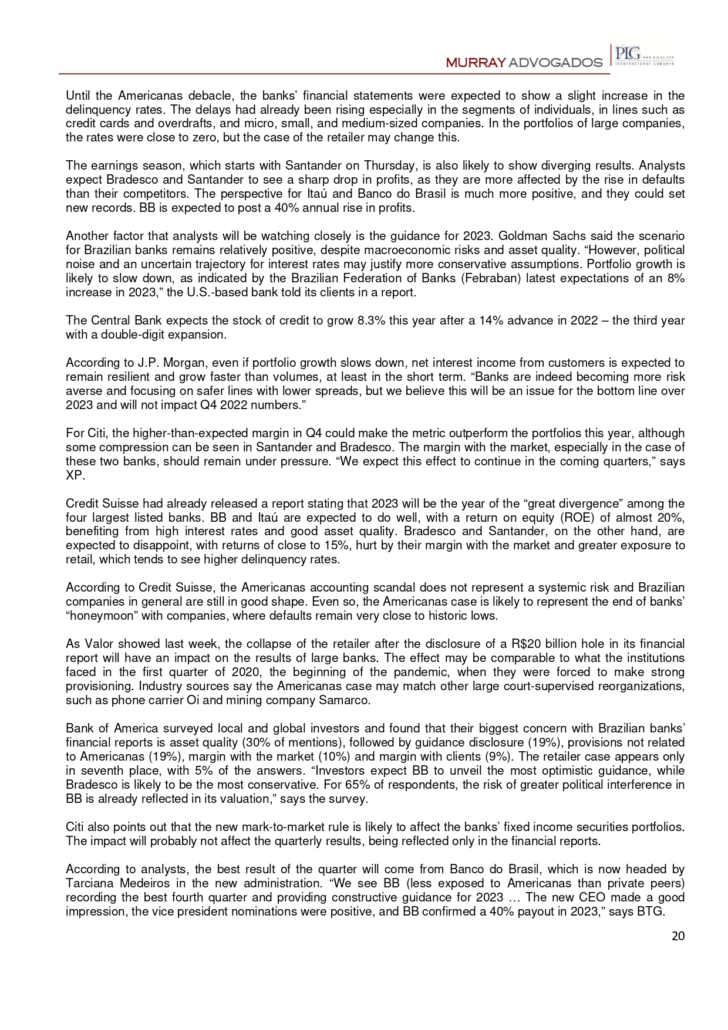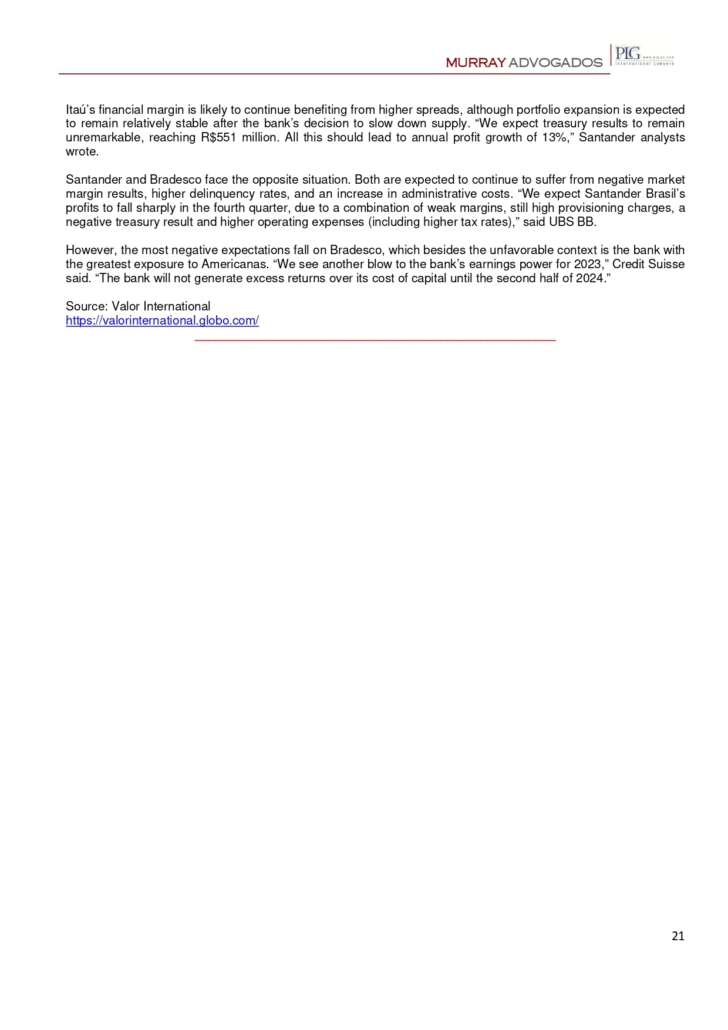Analysts predict that Brazil’s four largest banks will report divergent performances
01/31/2023
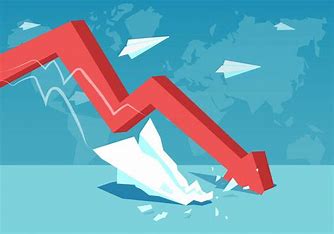
Bank’s earnings season starting Thursday is expected to show an even stronger growth of credit portfolios in the fourth quarter of 2022 and batter financial margins. The big unknown factor is the impact of the court-supervised reorganization of retail giant Americanas on the delinquency rate and profits.
According to a survey of eight banks by Valor, the four largest publicly-traded banks – Itaú Unibanco, Bradesco, Santander, and Banco do Brasil (BB) – are likely to post a combined profit of R$23.3 billion, down 6.1% compared with the second quarter and 1.4% compared with the third quarter of last year. This figure, however, may turn out to be very different depending on the strategy that each bank adopts to provision for credit losses with the Americanas case. Not all analysts in the sample included this impact in their projections.
The lenders can make provisions in the balance sheets for the fourth quarter of 2022 or the first quarter of 2023, since the case broke out in early January. Some banks have already signaled that they intend to make the adjustment in last year’s results. There is no rule for this, but it is customary in the market to build a reserve of at least 50% of exposure to a client with a distressed loan.
Until the Americanas debacle, the banks’ financial statements were expected to show a slight increase in the delinquency rates. The delays had already been rising especially in the segments of individuals, in lines such as credit cards and overdrafts, and micro, small, and medium-sized companies. In the portfolios of large companies, the rates were close to zero, but the case of the retailer may change this.
The earnings season, which starts with Santander on Thursday, is also likely to show diverging results. Analysts expect Bradesco and Santander to see a sharp drop in profits, as they are more affected by the rise in defaults than their competitors. The perspective for Itaú and Banco do Brasil is much more positive, and they could set new records. BB is expected to post a 40% annual rise in profits.
Another factor that analysts will be watching closely is the guidance for 2023. Goldman Sachs said the scenario for Brazilian banks remains relatively positive, despite macroeconomic risks and asset quality. “However, political noise and an uncertain trajectory for interest rates may justify more conservative assumptions. Portfolio growth is likely to slow down, as indicated by the Brazilian Federation of Banks (Febraban) latest expectations of an 8% increase in 2023,” the U.S.-based bank told its clients in a report.
The Central Bank expects the stock of credit to grow 8.3% this year after a 14% advance in 2022 – the third year with a double-digit expansion.
According to J.P. Morgan, even if portfolio growth slows down, net interest income from customers is expected to remain resilient and grow faster than volumes, at least in the short term. “Banks are indeed becoming more risk averse and focusing on safer lines with lower spreads, but we believe this will be an issue for the bottom line over 2023 and will not impact Q4 2022 numbers.”
For Citi, the higher-than-expected margin in Q4 could make the metric outperform the portfolios this year, although some compression can be seen in Santander and Bradesco. The margin with the market, especially in the case of these two banks, should remain under pressure. “We expect this effect to continue in the coming quarters,” says XP.
Credit Suisse had already released a report stating that 2023 will be the year of the “great divergence” among the four largest listed banks. BB and Itaú are expected to do well, with a return on equity (ROE) of almost 20%, benefiting from high interest rates and good asset quality. Bradesco and Santander, on the other hand, are expected to disappoint, with returns of close to 15%, hurt by their margin with the market and greater exposure to retail, which tends to see higher delinquency rates.
According to Credit Suisse, the Americanas accounting scandal does not represent a systemic risk and Brazilian companies in general are still in good shape. Even so, the Americanas case is likely to represent the end of banks’ “honeymoon” with companies, where defaults remain very close to historic lows.
As Valor showed last week, the collapse of the retailer after the disclosure of a R$20 billion hole in its financial report will have an impact on the results of large banks. The effect may be comparable to what the institutions faced in the first quarter of 2020, the beginning of the pandemic, when they were forced to make strong provisioning. Industry sources say the Americanas case may match other large court-supervised reorganizations, such as phone carrier Oi and mining company Samarco.
Bank of America surveyed local and global investors and found that their biggest concern with Brazilian banks’ financial reports is asset quality (30% of mentions), followed by guidance disclosure (19%), provisions not related to Americanas (19%), margin with the market (10%) and margin with clients (9%). The retailer case appears only in seventh place, with 5% of the answers. “Investors expect BB to unveil the most optimistic guidance, while Bradesco is likely to be the most conservative. For 65% of respondents, the risk of greater political interference in BB is already reflected in its valuation,” says the survey.
Citi also points out that the new mark-to-market rule is likely to affect the banks’ fixed income securities portfolios. The impact will probably not affect the quarterly results, being reflected only in the financial reports.
According to analysts, the best result of the quarter will come from Banco do Brasil, which is now headed by Tarciana Medeiros in the new administration. “We see BB (less exposed to Americanas than private peers) recording the best fourth quarter and providing constructive guidance for 2023 … The new CEO made a good impression, the vice president nominations were positive, and BB confirmed a 40% payout in 2023,” says BTG.
Itaú’s financial margin is likely to continue benefiting from higher spreads, although portfolio expansion is expected to remain relatively stable after the bank’s decision to slow down supply. “We expect treasury results to remain unremarkable, reaching R$551 million. All this should lead to annual profit growth of 13%,” Santander analysts wrote.
Santander and Bradesco face the opposite situation. Both are expected to continue to suffer from negative market margin results, higher delinquency rates, and an increase in administrative costs. “We expect Santander Brasil’s profits to fall sharply in the fourth quarter, due to a combination of weak margins, still high provisioning charges, a negative treasury result and higher operating expenses (including higher tax rates),” said UBS BB.
However, the most negative expectations fall on Bradesco, which besides the unfavorable context is the bank with the greatest exposure to Americanas. “We see another blow to the bank’s earnings power for 2023,” Credit Suisse said. “The bank will not generate excess returns over its cost of capital until the second half of 2024.”
*By Álvaro Campos — São Paulo
Source: Valor International
LVHM, L’Oréal, and Shiseido are among those interested in buying business
01/31/2023
/i.s3.glbimg.com/v1/AUTH_37554604729d4b2f9f3eb9ad8a691345/internal_photos/bs/2023/9/H/GmSxLRSpaScEo6o2eImA/31emp-100-natura-b1-img01.jpg)
Aesop’s market capitalization of $2 billion is higher than expected, according to a report by Citi — Foto: Silvia Costanti/Valor
Natura has started receiving preliminary consultations for the purchase of a stake in Aesop, a luxury brand of the Brazilian cosmetics giant, sources say. Bloomberg reported earlier that French group LVMH, L’Oréal, and Japan’s Shiseido were among those interested in a transaction that would value Aesop at around $2 billion.
Sources familiar with the matter heard by Valor confirmed the interest of competitors in the Brazilian company’s brand and said that L’Occitane and private equity funds, such as CVC Partners, were also interested in the financial data of Aesop, a brand founded in Australia and acquired by Natura in 2013. The Brazilian company is exploring the sale of a stake or 100% of the brand, depending on the proposals on the table.
Aesop’s market capitalization of $2 billion is higher than expected, according to a report by Citi. The bank’s analysts say this value implies a multiple of 16.5 times EBITDA, which would be positive for Natura if the stake were sold at this price. The bank points out that the sale of a 25% stake on these terms would reduce the company’s leverage to a ratio of 2 times net debt-to-EBITDA from 2.9 times.
Citi has a neutral recommendation on Natura &Co, with a price target of $13. On Monday, Natura shares closed up 5.49% at R$13.65, driven by the interest of competitors in Aesop. Over the year, the shares have gained 17.5%. Over 12 months, however, the shares fell 36.1%, according to Valor Data. Natura has a market capitalization of R$18.8 billion.
There is still no formal proposal for the business, people familiar with the matter say. Initially, Natura intended to do the brand split or even an IPO. Market conditions are not yet favorable for going public.
The Brazilian company is being advised by Bank of America and Morgan Stanley. The banks are exploring what should be the best financial arrangement to give greater liquidity to the Brazilian company, which announced last year a broad restructuring of its business.
In June last year, Natura changed the command of the group to turn around its business after reporting bad results and see stocks plummet during the pandemic. Fábio Barbosa, an executive who was already a member of the board of directors, has replaced Roberto Marques as CEO of Natura & Co.
Invited by the main stockholders of the group, Mr. Barbosa has taken the mission to simplify the holding structure, improve the margins and the company’s results, and reposition the brands Aesop, Avon, Natura, and The Body Shop.
In the third quarter, the company’s net revenue totaled R$9 billion, down 5.7% year-over-year. In the period, the holding company reported a loss attributable to the controlling shareholders of R$560 million, reversing the profit of R$273 million in the third quarter of last year. The Aesop brand’s invoicing grew 21.5%, ending the third quarter at R$602.6 million.
In a recent interview with the Financial Times, Mr. Barbosa said that the company will focus on margins and cash generation rather than sales growth. The group’s expansion movement has also ceased. The management has been reviewing Natura’s business model and its presence in underperforming markets.
The company is working to make the integration of Natura and Avon in Latin America, a movement that was already demanded by the financial market.
Natura, LVMH, L’Oréal, and Shisheido declined to comment on the matter. CVC Partners and L’Occitane did not immediately reply to requests for comment.
(Felipe Laurence contributed to this story.)
*By Monica Scaramuzzo — São Paulo
Source: Valor International
Strong investor demand and positive profitability of agricultural production were key factors, says global report
30/01/2023
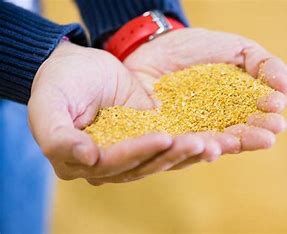
Prices for farmland dedicated to cereal grains in Brazil rose by an average of 45% year-on-year in 2022. The average value per hectare of soybean and corn plantations, for example, rose to R$53.300 from R$36.700, driven by strong investor demand in this market and the positive profitability of agricultural production, despite high costs, according to the most recent report by S&P Commodity Insights.
In three years, the appreciation of the country’s farmland has reached 127.4%. In 2019, the average value of a hectare dedicated to grain production was R$23,400. During the same period, sugarcane plantations also became more expensive (93.3%, going to R$46,300 from R$23,900), pastureland (60.6%, to R$13,200 from R$8,200), coffee (132.1%, to R$44,000 from R$18,900) and planted forests (53.8%, to R$18,000 from R$11,700).
A more moderate market is expected in 2023, with prices rising at a slower pace. Those in the industry believe that there will be a window of opportunity for investors with liquidity to acquire land from the second half of the year.
Mario Lewandowski, head of new business at AGBI, believes that the maintenance of high costs in the rural areas, with the high interest rates, will come back to haunt some producers who have not planned well and have relied on leverage. The option for some, he said, will be to sell the land.
“Many farmers will find it difficult to pay last year’s installments and to get good loans this year, especially those who financed with more expensive money. Six months from now, with the increase in interest rates and costs, the farmer who did not make the right calculation will have to sell a piece of land,” Mr. Lewandowski told Valor.
In recent years, interest rates in the country have risen to 13.75% a year from as low as 2% in March 2021, with no signs of a sharp drop in the short term. “If there is a sharp fall in interest rates in the coming months, farmers will reorganize. Our understanding is that this is a good time to be liquid because opportunities will appear,” he added. AGBI is an investment manager focused on farmland and real assets.
Mr. Lewandowski argued that the price of land is not “good to buy” and that the indexes will not fall, as they are linked to the quotation of agricultural products and have the values constantly adjusted by inflation. However, there should be an adjustment while the market adjusts to the new conditions of interest rates and input costs. According to him, some prices on the market today are not “sustainable” and do not reflect the real value of the land.
This is what the market refers to as a wide price range. The S&P Global report shows that in Brazil’s Central-West region, the average land price in the last quarter of 2022 was R$26,700 per hectare. The survey identified areas priced at R$1,000 and others at R$124,000. In the South, the most consolidated and most highly valued region, land was valued at R$212,000 per hectare. The average price of land in Paraná, Santa Catarina and Rio Grande do Sul from October to December last year was R$56,800. The lowest price recorded for productive land in the country was in Pará, at R$300 per hectare.
AGBI’s first farm was purchased in 2013 for R$9,000 per usable hectare of pasture. In 2020, the same area was sold for R$50,000 after being converted to crops. Mr. Lewandowski says that there has been a change in prices and that it is unlikely that the management company will again be able to pay investors returns of 500%. “We will never again find land at R$9,000, but if we find it close to R$30,000 and sell it for R$60,000, we can double our capital just by playing it safe. We are confident that we can, at least, double it,” he predicted.
According to a report by S&P Global Commodity Insights, the market became more “subdued” in the last quarter of 2022 “due to high land prices, a contraction in some commodity indicators, and market sensitivity to the new federal administration.” Uncertainty over fiscal policy in Brasília, with potential implications for taxes, interest rates, and prices, can affect production costs and impact land prices, it says.
The international environment is also having an impact on the market, particularly with lower growth or a slowdown of Brazil’s main trading partners. “However, with the prospect of increased agricultural production in the country and consequent increase in domestic stocks, we could see some pressure on prices, which was not the case in last year’s crop, when stocks were limited,” says the report.
*By Rafael Walendorff — Brasília
Source: Valor International
On the eve of the Copom meeting, de-anchored inflation worries agents
01/30/2023
/i.s3.glbimg.com/v1/AUTH_37554604729d4b2f9f3eb9ad8a691345/internal_photos/bs/2023/2/0/MJlRO5R02qlX8H6ZAu7A/bc.jpg)
Agents expect key interest rate Selic to remain at 13.75% on Wednesday — Foto: Marcello Casal Jr/Agência Brasil
The recent criticism the current administration has made of inflation targets and the persistence of fiscal uncertainties have translated into a movement of de-anchoring of inflation expectations. That is happening in a scenario that increasingly detaches market agents from the prospect that the Central Bank’s Monetary Policy Committee (Copom) begins the cycle of interest rate cuts.
Despite that, the improvement in current inflation and signs of a turnaround in the trend of rising prices around the world are likely to oppose local noises and guarantee that Copom’s balance of risks remains symmetrical in Wednesday’s decision — even though the collegiate may use a harsher tone when addressing the detachment of expectations.
According to a survey conducted by Valor with 106 institutions, there is unanimity among the agents about the key interest rate Selic remaining stationary at 13.75% on Wednesday. For the end of the year, however, the projections range from cuts in the rate to 10.5% to a rise to 14.5% — the chance of an interest rate increase, however, is projected by only one institution.
However, the projections for the Selic have contemplated fewer and fewer cuts. While the median of the last survey carried out by Valor, in December, indicated the Selic at 12% at the end of this year, the number has jumped to 12.50% now.
At the same time that it expects a less intense monetary loosening cycle, the market has raised its inflation projections. The median of 102 estimates for inflation at the end of 2023 rose to 5.7% from 5.2% in December. For 2024, the midpoint of the projections jumped to 4% from 3.7%.
In the context of worsening inflationary expectations, financial agents expect the collegiate to harden the tone of communication, but not to change the balance of risks significantly yet.
“Given this very evident movement of unanchoring that is expected to continue, I wouldn’t be surprised if the committee stressed this issue,” says the chief economist for Brazil at BTG Pactual, Claudio Ferraz. He also reminds us that, in December, Copom has already demonstrated concern with expectations, when it pointed to the average of the benchmark inflation index IPCA projections for 2024.
A similar view is adopted by the chief economist at Truxt Investimentos, Arthur Carvalho. “By analyzing the communication from the Central Bank, it is possible to see that, little by little, it has been raising the tone a bit concerning fiscal policy and the potential effects on monetary policy. This was very clear in the letter about the 2022 target, which was not met, when the Central Bank shows that the more expansionary fiscal policy was part of the problem. And now, despite well-behaved current inflation and signs of a slowdown in the economy, the only explanation for the unanchoring of expectations is a fiscal environment that accommodates higher spending growth and makes the 3% inflation target not very credible.”
Mr. Carvalho says he has a feeling that Copom will, again, raise the tone regarding fiscal policy. “If we hadn’t seen this lack of support, Copom would probably be signaling the beginning of a process of loosening interest rates. I think the Central Bank will harden its tone, but despite that, the balance of risks will remain symmetrical,” he says. Truxt expects three 50 basis-points cuts in interest rates this year but emphasizes the uncertainty present in the scenario.
Claudio Ferraz, from BTG, observes that the recent movements induce the impression that the beginning of the Selic cuts “are more distant, smaller and, depending on decisions about the fiscal framework, perhaps the “terminal number” of the Selic will be higher. In an environment of de-anchoring of expectations, the space is exhausted.”
Without seeing significant changes that justify a change in the BC’s flight plan, XP’s chief economist Caio Megale believes that Copom should indicate that there are positive elements in the scenario but emphasize that “the concerns described in the past meeting have intensified.” “If Copom comes with a very different tone, it would be a surprise,” he says.
From now on, for Mr. Megale, the behavior of inflation projections for 2024 should be monitored. “When expectations rise, the Central Bank’s model has to incorporate a longer interest rate stop in order to achieve convergence. We believe that, up to the 4.5% level [for the IPCA of 2024], the Central Bank would manage to bring inflation to the target only with interest rates unchanged for a longer time. But if expectations exceed the top of the band, the scenario would be more difficult.”
And it is in the face of higher inflationary expectations and fiscal uncertainty that the chief economist at Garde Asset, Daniel Weeks, believes that Copom may change the balance of risks. “After the approval of the PEC, the fiscal risk increased and, more recently, we have seen communication by the Treasury and the president about inflation targeting, which affects the credibility of the CB and unanchoring expectations.”
For him, Copom should reinforce the message of maintaining a contractionary monetary policy for a prolonged time. “I think the Central Bank should have already changed the balance of risks in December, when there was already a worsening because of fiscal risk. I don’t know if it will change now, but it should, because, from the last Copom to here, we saw the approval, in fact, of the PEC [proposal to amend the Constitution] and, now, a worsening of expectations and pressure on the Central Bank itself.”
When simulating the Central Bank models, EQI Asset’s chief economist, Stephan Kautz, expects the projection for the IPCA of 2023 to rise to 5.2% from 5% and that the estimate for the IPCA of 2024 will go to 2.9% from 3%. “This is because, concerning the last Copom, there was an improvement in the exchange rate and the trajectory of the Selic in 2023 went to 12.5% from 11.75%. The lower exchange rate and higher interest rates offset the shock in expectations and the projections may move little,” he says.
Mr. Kautz believes, however, that the members of Copom may seek to convey a slightly more cautious message about the de-anchoring of expectations and reminds us that part of the Central Bank’s credibility depends on the anchoring of inflation over the medium term.
*By Gabriel Roca, Victor Rezende — São Paulo
Source: Valor International
Projections for the shorter term continue to deteriorate, driven in large part by the prospect of higher fuel prices
01/30/2023
/i.s3.glbimg.com/v1/AUTH_37554604729d4b2f9f3eb9ad8a691345/internal_photos/bs/2022/K/O/J5MU4DRbAAX68TwAaXQQ/bancocentral.jpg)
Central Bank’s building in Brasília — Foto: Jorge William/Agência O Globo
Inflation expectations in the financial market have deteriorated again just days before the meeting of the Central Bank’s Monetary Policy Committee (Copom), which will unveil its decision on Wednesday.
The trend of deteriorating inflation projections for shorter terms continues, mainly driven by the prospect of higher fuel prices. In longer terms, fiscal uncertainty and the noises generated by President Luiz Inácio Lula da Silva’s remarks on a possible revision of inflation targets are weighing.
In one week, the measured forecast by economic analysts for inflation in 2023 rose to 5.74% from 5.48%. Part of the increase is due to the likely end of the federal gasoline tax holiday in March. The reopening of China’s economy also tends to put more pressure on oil prices. The forecast for regulated prices rose to 8.39% from 7.25%.
However, this deterioration in short-term inflation, however, is unlikely to have a significant impact on the conduct of monetary policy. From this meeting on, the Copom will focus mainly on the 2024 inflation target. Policymakers have stated that they are focusing on inflation six quarters ahead, that is, inflation up to September 2024. By then, most of the pressure on regulated prices is likely to have dissipated.
The point is that inflation expectations for 2024 are also deteriorating. During the week, they went to 3.9% from 3.84%. At the last Copom meeting in December, it was 3.5%, already above the target of 3% for the year.
This worsening of expectations in the so-called relevant horizon for monetary policy – in other words, the period in which the Central Bank proposes to achieve the target – creates an additional constraint for the conduct of monetary policy. But one must not exaggerate. The Central Bank’s decisions are based on policymakers’ projections. The Central Bank usually reacts with further monetary tightening if its projections show a statistically relevant deviation from the target.
It is very likely that the monetary authority will keep its own estimates below the market. In December, the Copom projected inflation at 3% for 2024, below the market’s estimate of 3.5%.
The deterioration in market inflation expectations is expected to weigh on the Central Bank’s own projections. On the other hand, the Central Bank asked for market estimates of the expected fiscal expansion in 2023. According to the December survey, public spending is expected to increase by R$140 billion above the cap.
The Central Bank, on the other hand, does not have many additional reasons to raise its inflation projections for 2023, since its scenario already includes the expiration of the tax cuts. As a result, one should not expect much more inflationary inertia in 2024.
But there are factors that point in the opposite direction: the exchange rate has appreciated since December. In addition, the interest rate level used in the Central Bank’s forecasting model is likely to be much higher.
The Central Bank feeds its projections with market expectations for the Selic, which is Brazil’s key interest rate. In December, the start of the reduction cycle was expected for August. Now, for November.
In other words, thanks to the exchange rate and the monetary tightening that occurs within the model itself, even with the short-term Selic at current levels, the Copom may be able to present a somewhat stable inflation projection for 2024.
One should also keep in mind that the Central Bank looks carefully at other factors in making its decision. There is a component that looks backward, not just forward. The Copom has been looking carefully at the evolution of services inflation and the economic slack.
The question is how the Central Bank will deal with the deterioration in the market’s perception of fiscal risk and the risk of a change in the inflation targets, which has raised the experts’ longer-term projections. The median projection for 2025 was unchanged at 3.5% last week, and expectations for 2026 rose to 3.5% from 3.47%. At the December meeting, they were close to 3%.
Strictly speaking, these years are too far away to affect the most immediate conduct of monetary policy. But they are a very strong warning about fiscal risks. If the Central Bank were to say that fiscal risks to inflation predominate, this would theoretically require more action on interest rates.
But that seems unlikely, at least in the short term. The Central Bank has advocated calm in its assessment of fiscal risks, so one should not expect a clear warning. As for President Lula’s remarks about a possible change in inflation targets, Central Bank President Roberto Campos Neto tried to pour oil on troubled waters by saying that there were distortions in relation to what was said.
Moreover, fiscal risk is not the only news lately. The exchange rate has fallen, despite all the market fears about the public accounts, due to a more favorable international scenario than expected. The reopening of China is boosting commodity prices, and the scenario for activity and inflation in the developed world seems less gloomy.
In the past, under Ilan Goldfajn, the Central Bank liked to see the fiscal risk in its international context. The message at the time was that what was really worrying was the combination of fiscal risks with the international environment for emerging markets.
*By Alex Ribeiro — São Paulo
Several pharmaceutical groups warn about distortions resulting from new price list of different drugs
01/27/2023

Brazilian drugmakers, including those focused on generic medicines, asked the government of São Paulo to suspend the ordinance that raised medicine prices amid a risk of “occasional shortages” of certain treatments.
In letters sent Thursday to the state’s revenue service, FarmaBrasil – a trade group that represents large companies like Aché, Biolab, EMS, Eurofarma, Hypera, and Libbs) – and the PróGenéricos and Alanac organizations warned about distortions arising from the new list of Weighted Average Price to the Final Consumer (PMPF) of different products, and ask the authorities that the ordinance, which will come into force on February 1, be suspended until the “inconsistencies” are clarified.
Several states announced higher sales tax ICMS rates for medicines at the end of last year, which will be reflected in price increases as of February.
In São Paulo, there was no increase in the rate, but there was in the PMPF, with an impact on prices.
In a letter, FarmaBrasil points out that even the revised list of PMPFs in São Paulo, after warnings to Sindusfarma, maintained distortions and the average weighted price of certain drugs reaches 100% of the maximum price to the consumer imposed by the Chamber for Drug Market Regulation (CMED), the federal agency that regulates the market, after the change in rules.
“Such measure, if not reviewed, will make the commercialization of several drugs unfeasible, which may become commercially unviable and even cause specific shortages,” the trade association said in the letter.
PróGenéricos and Alanac, in turn, asked for the maintenance of the previous ordinance and immediate suspension of the new one at least until the meeting scheduled for January 31, when such distortions are expected to be discussed.
In a note, the Secretariat of Finance and Planning recalled that it extended by five months the application of the new PMPFs, which should have occurred in August. The secretariat “will maintain contacts with the sector, upon request, to address specific cases in which some reference prices may have exceeded the maximum price to the consumer set by the Chamber for Drug Market Regulation,” says the note, adding that the ordinance “already provides for the treatment for these cases, which will be duly clarified to representatives of the sector.
*By Stella Fontes — São Paulo
Deal between one of Brazil’s largest regional food retail companies and cash-and-carry chain involved sale of properties, not stores
01/27/2023
/i.s3.glbimg.com/v1/AUTH_37554604729d4b2f9f3eb9ad8a691345/internal_photos/bs/2022/F/e/D0KyyMQ3S6GGjq1neEiA/screenshot-41.jpg)
Makro store in São José dos Campos — Foto: Reprodução/Youtube
Grupo Muffato, one of the country’s largest regional food retail chains, has agreed to buy 16 properties and 11 gas stations from Makro, sources say. The group and the cash-and-carry chain confirmed the deal on Thursday.
In São Paulo, the properties were acquired in the neighborhoods of Butantã, Lapa, and Interlagos – stores considered among the best –, and others in the cities of Guarulhos, Marília, Piracicaba, Presidente Prudente, Santo André, São Bernardo do Campo, São José do Rio Petro, Sorocaba (two units), São José dos Campos, Taubaté, Campinas, and Mogi das Cruzes.
The transaction involved the sale of the company’s real estate, not the businesses. There are 24 Makro units in Brazil, and the company has been trying to sell all of its properties and exit the Brazilian market since at least last year, as Valor reported at the time.
Muffato had been studying the assets for months, and despite the differences in price analysis between the parties, it remained interested in some properties.
During the talks, the group was advised by XP Investimentos and law firms Marins Bertoldi Advogados and Mattos Filho Advogados. Makro Brasil received financial advice from Santander and legal advice from Mello e Torres Advogados.
Industry sources estimate the value of the deal at between R$800 million and R$1.1 billion. The company did not disclose a figure. XP reportedly helped find lines in the market to finance part of the purchase.
“The asset transfer process is expected to be completed in the shortest possible time, subject to the fulfillment of certain conditions, including the approval of CADE,” the companies said in a note, citing Brazil’s antitrust regulator.
Valor reported in December that the Dutch company had been exploring the sale of the properties through Santander, which has a mandate in the transaction.
*By Adriana Mattos — São Paulo
Source: Valor International
Erasmo Carlos Battistella calls for guarantee of predictability, industrial policy, to announce investments
01/27/2023
/i.s3.glbimg.com/v1/AUTH_37554604729d4b2f9f3eb9ad8a691345/internal_photos/bs/2022/X/9/AaBtrMTMimbQP8QWuxAg/030220ecbgroup013.jpg)
Erasmo Carlos Battistella — Foto: Claudio Belli/Valor
Erasmo Carlos Battistella, the country’s top biodiesel businessman, is hoping that the government will soon set up its technical team, mainly in the Ministry of Mines and Energy (MME), to present the request to increase the biodiesel blend in diesel from the current 10% (B10) to 15% (B15) from March. The Bolsonaro administration’s decision to introduce B10 is only valid until the end of February, and by then the Lula administration will have to make a decision about the blend.
According to the schedule of the National Program for the Production and Use of Biodiesel (PNPB), B15 should be commercialized as of March this year. However, the previous administration already failed to meet the plan’s schedule by reducing the blend to 10% last year, when it should have been 14%.
The decision froze new investments in the area, including a R$2 billion package by Mr. Battistella’s BSBIOS. According to him, if the new administration resumes the original blending plan, the company can resume its investment plan.
“If B15 returns, BSBIOS will announce new investments in Brazil. Meanwhile, we are making other [investments] abroad,” he said. On the international front, the company’s latest move was to acquire the La Paloma soybean crushing and biodiesel production complex in Paraguay earlier this month.
“We have not [invested in Brazil], but we have not stopped projects. We are working on the engineering part, on the environmental licensing and the projects are ready. What we need is B15, the guarantee of predictability and the existence of an industrial policy,” said Mr. Battistella.
However, he defended that the creation of the government’s technical team should be accelerated. “We are already at the end of January and there are other sectors like us that need to talk to the government,” he said. “We have a dialogue [with the new administration], but we have not yet managed to set up formal meetings as a sector,” he said.
Businesspeople and representatives of the sector are also planning to present the government’s technical team with a plan to review the deadlines for meeting the National Policy for Biofuels (RenovaBio) targets. The last administration extended the deadline for meeting the 2022 target to September this year and said that from 2023 the deadline could be met by March of the following year. The measure caused the price of Decarbonization Credits (CBio) to fall and clouded the long-term scenario of the program.
For the businessman, the Brazilian government needs to move forward with biofuel regulation to close the country’s gap in this area and advance the decarbonization agenda. “Brazil is ten years behind the U.S. in terms of biofuels: we have no regulation for the use of green diesel, we have no regulation for the use of aviation biokerosene (SAF), and we are stuck at B10, while in the U.S. the floor [of the blend] is B20,” criticized the Mr. Battistella, who is attending an international conference on biofuels organized by the Clean Fuels Alliance America.
For him, the zero deforestation policy alone is not enough. “It needs to reduce emissions in land, maritime, and air transport.”
The biofuel leader praised the re-creation of the Ministry of Development, Industry and Trade (Mdic), which is expected to create lines of credit to support industrialization with reduced rates. “Today we have an interest rate that hinders investments not only in industry but in all sectors,” said Mr. Battistella.
In turn, the likely return of Petrobras’ protagonism in areas other than oil and gas, such as in biofuels, is being closely watched by Mr. Battistella, a former partner of the state-owned company in BSBIOS. “I hope it will come back to the [biofuels] sector with the great strength it has, but aligned with the production sector, to add and not to divide. If it is to add, it will be a great reinforcement. If it is to divide, it will be bad. But I expect that it will add”, he said.
*By Camila Souza Ramos — São Paulo
Source: Valor International
Retail giant is analyzing financing alternatives and approaching funds and investors
01/27/2023
/i.s3.glbimg.com/v1/AUTH_37554604729d4b2f9f3eb9ad8a691345/internal_photos/bs/2023/Z/b/s8daoDSUiysvJ4TODS5w/27emp-100-americanas-b5-img01.jpg)
It becomes imperative to establish a credit structure for Americanas to maintain operations — Foto: Gustavo Minas/Bloomberg
Americanas needs to keep operations running in the coming weeks while it begins to put together its court-supervised reorganization plan, and some emergency solutions are in sight, sources say. As inventories, especially of food and beverages, dwindle and lines of credit from banks and suppliers are severely reduced or closed for more than 10 days, it becomes imperative to establish a credit structure for the operation.
Retail is one of the businesses most dependent on this flow because it finances its customers. Brazilian retailers typically offer buy-now-pay-later options, but pay suppliers in shorter periods, making the need for working capital intense. If this system comes to a halt, there are few options to try to breathe new life into it, given the high dependence on bank and industry lines.
Sources say that the company’s primary – Jorge Paulo Lemann, Marcel Telles, and Beto Sicupira – have been exploring groups of investors and banks not affected by the current crisis to create a credit fund with the company’s receivables. “It is not yet clear whether there is support from investors for this idea,” says a person familiar with the matter. In this operation, the bank would take the receivables from credit cards, pass on the funds to Americanas, and receive the payment flow, with a discount for the payment in advance.
This is a typical transaction in the market, made directly by retailers with lenders. However, in this case, the factoring of receivables has been the target of cancellation in the last two weeks. In September, Americanas had R$5.2 billion in card receivables.
“The point is that due to the risk of the chain there is no guarantee that this will not end up in the court-supervised reorganization, even if the receivables are owned by the company that is being restructured. The pressure from the banks on any loans it may have is likely to weigh,” says a second source.
Another avenue that has been well received by the market in recent supervised reorganizations, involves debtor-in-possession (DIP) financing, Valor has learned, a financing operation that only happens in court-supervised reorganizations, and can be done with investment funds.
Included in the 2020 bankruptcy law reform, the financing model allows for the receipt of value outside the meeting of creditors, which may encourage financiers.
But to move forward, it would require the approval of creditors and the judge in the case – and the company is still in the process of defining its court-supervised reorganization plan within 60 days. Americanas had its reorganization petition accepted last Friday. The DIP investor may still have advantages in the negotiation of assets — the retailer is studying the sale of businesses to pay creditors, such as Hortifruti Natural da Terra.
There are also rumors in the market about the possibility of the chain negotiating short-term, high-rate bridge financing with investment banks or risk investors, whose guarantee would be the units or assets of Lojas Americanas, says a third source. “The problem is that since the terms are very short, the interest is quite high in the month, and you would have to have another quick solution at the end of the loan term,” says a real estate fund manager. Americanas declined to comment.
Today, about R$1.65 billion in debts of the chain with banks BTG, BV, Safra, and Bradesco are blocked due to the court-supervised reorganization. In September 2022, in cash and equivalents, Americanas had about R$4.3 billion. This amount reached R$7.8 billion on January 12, soon after the company reported the investigation on “accounting inconsistencies” of R$20 billion in its financial statements. Just six days later, this amount had already fallen to R$800 million — equivalent to almost half of the labor obligations in September 2022 – as banks froze their open lines.
In a separate development, a São Paulo State Court has accepted Bradesco’s request for the early production of evidence against Americanas. A search and seizure warrant was granted in order to copy the e-mails of directors, board members, and other employees and former employees of the company in the last 10 years. It is a victory in the strategy of the big banks, which are the main creditors of the retailer, to hold the primary shareholders liable for the “accounting inconsistencies” of R$20 billion.
In her decision, Judge Andréa Galhardo Palma says that even though Americanas has allegedly adopted measures to investigate the facts, such as the creation of an “independent committee,” the risks of destruction or damage of documentary evidence — such as e-mails, letters, and internal reports, are not unlikely — are not unlikely “given the high possibility of individual responsibility in various spheres (criminal, administrative, civil) of the agents involved in the alleged fraud.”
In its petition, Bradesco, which is the largest creditor of the retailer, with an exposure of R$4.8 billion, stated that “it is necessary to find the architects of the fraud, as well as those who, violating their fiduciary duties within Americanas, were complacent with the scheme.” The petition was filed by Warde Advogados. Americanas said in a statement that it will wait to be formally notified of the decision to adopt the appropriate measures.
The bank also said that the committee created by Americanas to investigate the case “has nothing independent.” In response, the committee said that the accusations are frivolous and unfounded.
As Valor has shown, Bradesco, Itaú Unibanco, and Santander are seeking the early production of evidence so that, if fraud is proven, they can adopt other legal strategies. One of them is to request the disregard of the legal entity of Americanas, which could pave the way to access the personal assets of the trio of shareholders. Santander requested that in addition to the e-mails of executives and board members, all correspondence — including letters and/or messages sent through WhatsApp, Telegram, or any social media — regarding the reverse factoring operations and any other related to the “accounting inconsistencies” reported by the retailer be immediately presented.
(Talita Moreira, Álvaro Campos, Rodrigo Carro contributed to this story.)
*By Adriana Mattos — São Paulo
Source: Valor International

